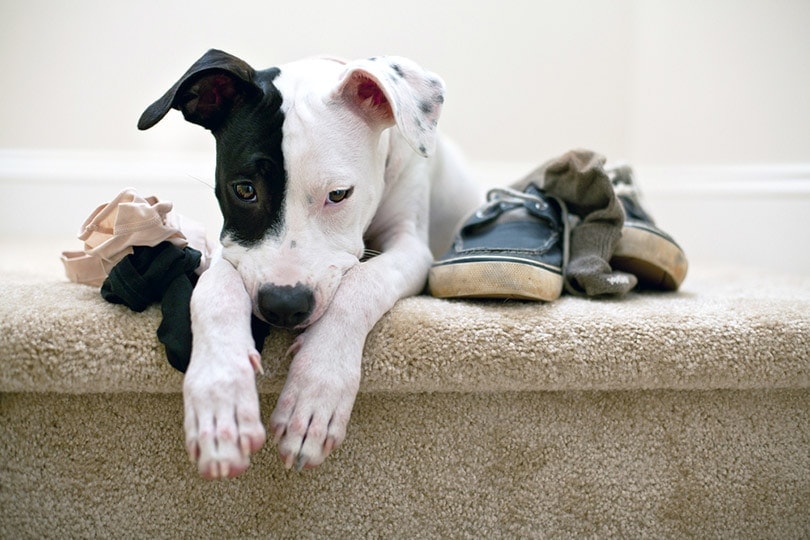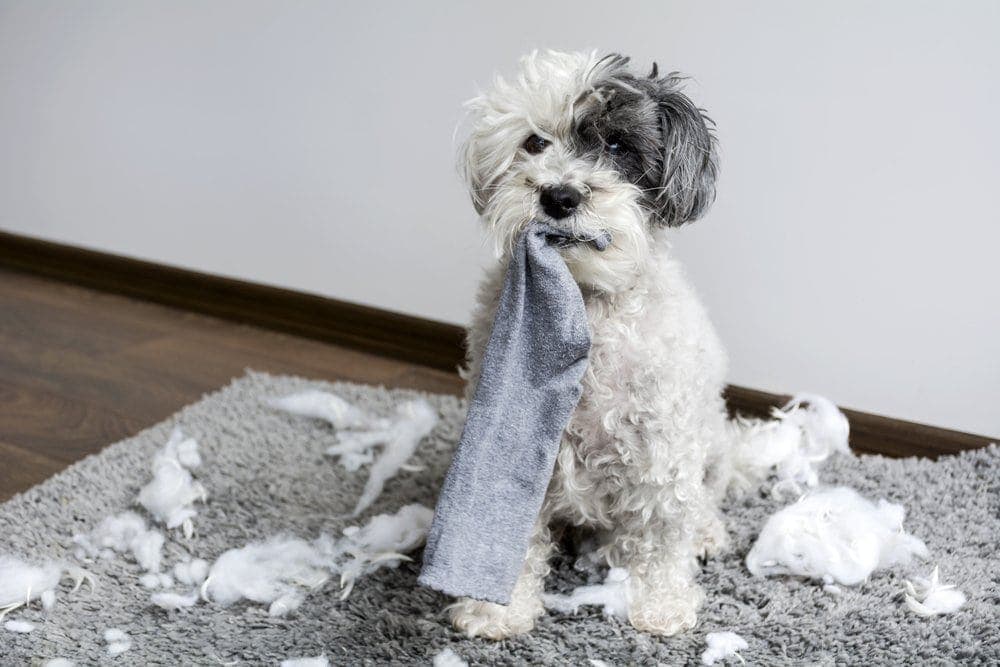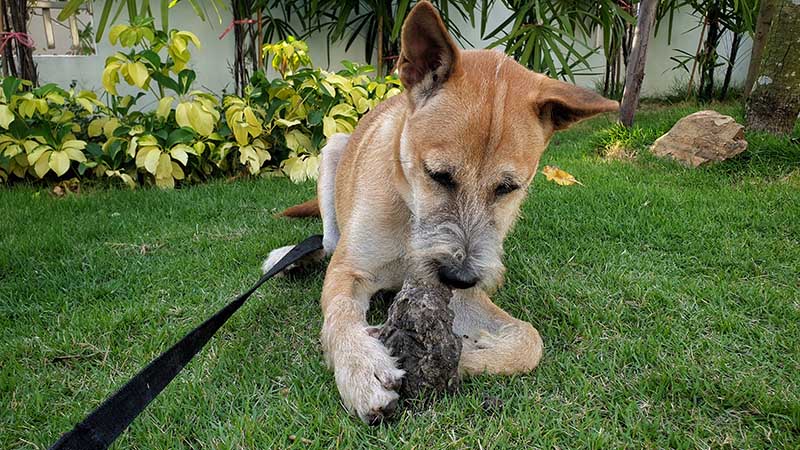Why Does My Dog Steal My Underwear? 5 Reasons & How To Stop It

Updated on

Caring for a dog is a rewarding experience, but the animal can test your patience when they steal your underwear or other clothes. Undergarment theft is not uncommon with canines, and in some cases, the dog will not destroy the garment or ingest it. However, it’s a behavior that must be corrected to avoid an injury and costly visit to the veterinarian’s office.
Dogs and puppies enjoy chewing on items with their owners’ scent, but any ingested object poses a severe risk for injury.
The 5 Reasons Your Dogs Steal Underwear
1. Boredom
Daily exercise is vital to a canine’s health, but mental stimulation can be just as important. Working breeds and dogs with higher intelligence are more likely to become destructive when their physiological needs are not met.
If you have an active dog that craves attention, they can act out when you’re away from home. Without toys or activities to keep the animal busy, they may decide to raid your hamper or underwear drawer for entertainment. Dirty underwear is a prime target because it smells like the family, and the dog may feel more comfortable chewing it than an object without a strong scent.
2. Anxiety
Dogs suffering from anxiety can also resort to chewing on clothes, furniture, or other items around the house. Determining the source of the stress will help you correct the behavior. If your pet’s routine has been interrupted by moving to a new home, it may take several days or weeks to adapt to the new surroundings.
A new baby or pet in the house can also cause the dog to misbehave when it feels unsure about the new guests. The anxiety can go away if the dog becomes accustomed to the new situation, but you can help the dog feel at ease by providing plenty of love, healthy treats, and mental stimulation.
Pets with severe anxiety need to be taken to the veterinarian for a complete examination. The doctor may prescribe a calming medication to help the pup return to normal.
3. Teething
If you’ve lived with a puppy, you probably noticed they were fond of chewing everything in the house, including your hands. When puppies are teething, a sock or pair of underwear feels soothing to their aching jaws. Most chew toys are unsuitable for young pups since they can damage immature teeth and gums.
However, you can use dental chews to satisfy the animal’s need to chew. Check the manufacturer’s instructions and warnings to ensure the product is safe before feeding a dental chew to your little buddy.

4. Resource Guarding
People, dogs, and other animals exhibit resource guarding or possession aggression. Your dog may consider your underwear a valuable object that’s worth protecting. When the dog refuses to give up the item, you may be inclined to chase them around the house to retrieve the garment.
However, chasing the dog may be entertaining to them, and they’re likely to continue hoarding your underwear in hopes of enjoying another chase. Using training techniques such as saying, “Drop it” or “Leave it” will show that the behavior is inappropriate.
You can use a treat to reward the dog when the underwear is dropped, and eventually, they should understand that dropping the garment is more rewarding than holding on to it or chewing it.
5. Pica
Dogs that choose to chew or eat inorganic objects rather than food may be suffering from pica. Pica is a compulsive disorder that can have deadly consequences if the dog frequently consumes underwear or other objects. The condition can be caused by high stress levels, nutritional imbalances, starvation, thyroid issues, or diabetes.
When a dog frequently chews underwear and other clothes and pays less attention to food, they must be taken to a doctor for a complete examination. The veterinarian may perform urine or blood tests to rule out serious medical issues. Pica is rare, but it’s a problem that can only be treated by a veterinarian.

How To Stop Underwear Theft
The best way to prevent underwear theft is to deny access to the hamper, drawers, or laundry bin. If your dog opens the hamper with their muzzle or paws, you can buy one with a latch or secure it with duct tape. Drawers and closets can be secured with child-proof tabs that prevent easy entry. Although this will save your underwear and prevent accidental ingestion, you’ll also have to address the cause of the chewing.
You can provide more walks for exercise and extend your play sessions to help the animal burn off energy. Keep an ample supply of chew toys around and ensure your pet enjoys a healthy diet. Interactive toys can help dogs with boredom, and you could also consider adopting another pet to keep your dog stimulated.
These techniques can help your dog, but you must continue training to ensure your pet understands that chewing underwear is wrong. Yelling at the animal or chasing them will only reinforce the behavior, but positive reinforcement techniques are more effective.
Hopefully, when the pup is rewarded for dropping the object, they will become less enamored with your undergarments. If your canine does not respond to training and continues to chew everything, you’ll need to visit the veterinarian. In severe cases, a veterinary behaviorist may be required to evaluate the patient.
Conclusion
Underwear chewing does not sound appealing to humans, but it is a pleasant experience for most canines. Dogs will continue to chew whatever they see unless their family secures the hazardous items in the home and provides safe alternatives for chewing. Unless the dog has a condition that only a veterinarian can treat, you can correct the behavior and continue to wear underwear without bite marks.
Featured Image Credit: Tara Lynn and Co, Shutterstock











